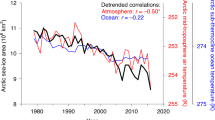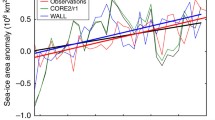Abstract
The predominant decadal to multidecadal variability in the Arctic region is a feature that is not yet well-understood. It is shown that the Barents Sea is a key region for Arctic-wide variability. This is an important topic because low-frequency changes in the ocean might lead to large variations in the sea-ice cover, which then cause massive changes in the ocean-atmosphere heat exchanges. Here we describe the mechanism driving surface temperatures and heat fluxes in the Barents Sea based primarily on analyzes of one global coupled climate model. It is found that the ocean drives the low-frequency changes in surface temperature, whereas the atmosphere compensates the oceanic transport anomalies. The seasonal dependence and the role of individual components of the ocean-atmosphere energy budget are analyzed in detail, showing that seasonally-varying climate mechanisms play an important role. Herein, sea ice is governing the seasonal response, by acting as a lid that opens and closes during warm and cold periods, respectively, thereby modulating the surface heat fluxes.















Similar content being viewed by others
References
Årthun M, Schrum C (2010) Ocean surface heat flux variability in the Barents Sea. J Mar Syst 83(1):88–98
Beitsch A, Jungclaus JH, Zanchettin D (2014) Patterns of decadal-scale Arctic warming events in simulated climate. Clim Dyn 43(7–8):1773–1789
Bengtsson L, Semenov VA, Johannessen OM (2004) The early twentieth-century warming in the Arctic-a possible mechanism. J Clim 17(20):4045–4057
Bjerknes J (1964) Atlantic air–sea interaction. Adv Geophys 10(1):82
Booth BB, Dunstone NJ, Halloran PR, Andrews T, Bellouin N (2012) Aerosols implicated as a prime driver of twentieth-century North Atlantic climate variability. Nature 484(7393):228–232
Chylek P, Folland CK, Lesins G, Dubey MK, Wang M (2009) Arctic air temperature change amplification and the Atlantic Multidecadal Oscillation. Geophys Res Lett 36(14):L14801
Delworth TL, Mann ME (2000) Observed and simulated multidecadal variability in the Northern Hemisphere. Clim Dyn 16(9):661–676
Frankcombe LM, Dijkstra HA (2010) Internal modes of multidecadal variability in the Arctic Ocean. J Phys Oceanogr 40(11):2496–2510
Gillett NP, Stone DA, Stott PA, Nozawa T, Karpechko AY, Hegerl GC, Wehner MF, Jones PD (2008) Attribution of polar warming to human influence. Nat Geosci 1(11):750–754
Glessmer MS, Eldevik T, Våge K, Nilsen JEØ, Behrens E (2014) Atlantic origin of observed and modelled freshwater anomalies in the Nordic seas. Nat Geosci 7:801–805
Goosse H, Holland MM (2005) Mechanisms of decadal Arctic climate variability in the Community Climate System Model, version 2 (CCSM2). J Clim 18(17):3552–3570
Jungclaus JH, Koenigk T (2010) Low-frequency variability of the Arctic climate: the role of oceanic and atmospheric heat transport variations. Clim Dyn 34(2–3):265–279
Levitus S, Matishov G, Seidov D, Smolyar I (2009) Barents Sea multidecadal variability. Geophys Res Lett 36(19):L19604
Mahajan S, Zhang R, Delworth TL (2011) Impact of the Atlantic Meridional Overturning Circulation (AMOC) on arctic surface air temperature and sea ice variability. J Clim 24(24):6573–6581
Marsland S, Bi D, Uotila P, Fiedler R, Griffies S, Lorbacher K, OFarrell S, Sullivan A, Uhe P, Zhou X et al (2013) Evaluation of ACCESS climate model ocean diagnostics in CMIP5 simulations. Aust Meteorol Oceanogr J 63(1):101–119
Massonnet F, Fichefet T, Goosse H, Bitz CM, Philippon-Berthier G, Holland MM, Barriat PY (2012) Constraining projections of summer Arctic sea ice. Cryosphere 6(6):1383–1394
Miles MW, Divine DV, Furevik T, Jansen E, Moros M, Ogilvie AE (2014) A signal of persistent Atlantic multidecadal variability in Arctic sea ice. Geophys Res Lett 41(2):463–469
Parker D, Folland C, Scaife A, Knight J, Colman A, Baines P, Dong B (2007) Decadal to multidecadal variability and the climate change background. J Geophys Res Atmos 112:D18115
Polyakov I, Alekseev G, Timokhov L, Bhatt U, Colony R, Simmons H, Walsh D, Walsh J, Zakharov V (2004) Variability of the Intermediate Atlantic Water of the Arctic Ocean over the last 100 years. J Clim 17(23):4485–4497
Polyakov IV, Bekryaev RV, Alekseev GV, Bhatt US, Colony RL, Johnson MA, Maskshtas AP, Walsh D (2003) Variability and trends of air temperature and pressure in the maritime Arctic, 1875–2000. J Clim 16(12):2067–2077
Proshutinsky AY, Johnson MA (1997) Two circulation regimes of the wind-driven Arctic ocean. J Geophys Res Oceans 102(C6):12,493–12,514
Serreze MC, Barry RG (2011) Processes and impacts of Arctic amplification: a research synthesis. Glob Planet Change 77(1):85–96
Serreze MC, Barrett AP, Slater AG, Steele M, Zhang J, Trenberth KE (2007) The large-scale energy budget of the Arctic. J Geophys Res Atmos 112:D11122
Shaffrey L, Sutton R (2006) Bjerknes compensation and the decadal variability of the energy transports in a coupled climate model. J Clim 19(7):1167–1181
Smedsrud LH, Esau I, Ingvaldsen RB, Eldevik T, Haugan PM, Li C, Lien VS, Olsen A, Omar AM, Otterå OH et al (2013) The role of the Barents Sea in the Arctic climate system. Rev Geophys 51(3):415–449
Stroeve JC, Kattsov V, Barrett A, Serreze M, Pavlova T, Holland M, Meier WN (2012) Trends in Arctic sea ice extent from CMIP5, CMIP3 and observations. Geophys Res Lett 39(16):L16502
Van der Swaluw E, Drijfhout S, Hazeleger W (2007) Bjerknes compensation at high northern latitudes: the ocean forcing the atmosphere. J Clim 20(24):6023–6032
Taylor KE, Stouffer RJ, Meehl GA (2012) An overview of CMIP5 and the experiment design. Bull Am Meteorol Soc 93(4):485–498
Wouters B, Drijfhout S, Hazeleger W (2012) Interdecadal North-Atlantic meridional overturning circulation variability in EC-EARTH. Clim Dyn 39(11):2695–2712
Author information
Authors and Affiliations
Corresponding author
Rights and permissions
About this article
Cite this article
van der Linden, E.C., Bintanja, R., Hazeleger, W. et al. Low-frequency variability of surface air temperature over the Barents Sea: causes and mechanisms. Clim Dyn 47, 1247–1262 (2016). https://doi.org/10.1007/s00382-015-2899-0
Received:
Accepted:
Published:
Issue Date:
DOI: https://doi.org/10.1007/s00382-015-2899-0




